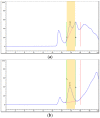Validation of Pretreatment Methods for the In-Process Quantification of Foot-and-Mouth Disease Vaccine Antigens
- PMID: 34835292
- PMCID: PMC8624908
- DOI: 10.3390/vaccines9111361
Validation of Pretreatment Methods for the In-Process Quantification of Foot-and-Mouth Disease Vaccine Antigens
Abstract
Foot-and-mouth disease (FMD), caused by the FMD virus (FMDV), is controlled by vaccine policy in many countries. For vaccine potency, the content of intact virus particles (146S antigens) is critical, and the sucrose density gradient (SDG) fractionation is the gold standard for the quantification of 146S antigens. However, this method has several drawbacks. Although size-exclusion high-performance liquid chromatography (SE-HPLC) was introduced to replace the classic method, its application is generally confined to purified samples owing to the interfering signals. Therefore, we aimed to develop optimal pretreatment methods for SE-HPLC quantification in less purified samples. Crude virus infection supernatant (CVIS) and semi-purified samples with PEG precipitation (PEG-P) were used. Chloroform pretreatment was essential to remove a high level of non-specific signals in CVIS, whereas it caused loss of 146S antigens without the distinctive removal of non-specific signals in PEG-P. Benzonase pretreatment was required to improve the resolution of the target peak in the chromatogram for both CVIS and PEG-P. Through spiking tests with pure 146S antigens, it was verified that the combined pretreatment with chloroform and benzonase was optimal for the CVIS, while the sole pretreatment of benzonase was beneficial for PEG-P.
Keywords: SE-HPLC; foot-and-mouth disease (FMD); pretreatment; quantification; vaccine antigen.
Conflict of interest statement
The authors declare no conflict of interest.
Figures





References
Grants and funding
LinkOut - more resources
Full Text Sources

